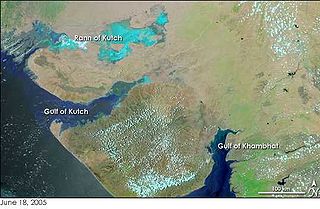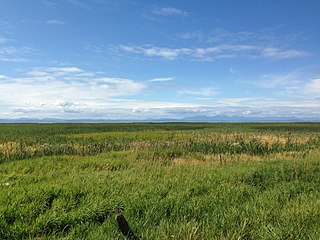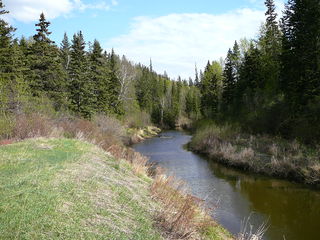Related Research Articles

A nature reserve is a protected area of importance for flora, fauna, or features of geological or other special interest, which is reserved and managed for purposes of conservation and to provide special opportunities for study or research. They may be designated by government institutions in some countries, or by private landowners, such as charities and research institutions. Nature reserves fall into different IUCN categories depending on the level of protection afforded by local laws. Normally it is more strictly protected than a nature park. Various jurisdictions may use other terminology, such as ecological protection area or private protected area in legislation and in official titles of the reserves.

The Gulf of Kutch is located between the peninsula regions of Kutch and Saurashtra, bounded in the state of Gujarat that borders Pakistan. It opens towards the Arabian Sea facing the Osman Gulf.
The Michigan Islands National Wildlife Refuge is a designation for nine Michigan islands in the North American Great Lakes. Owned by the United States federal government, they were set aside for ecosystem protection purposes by President Franklin D. Roosevelt 1943.

The Alaksen National Wildlife Area is located on Westham Island in the city of Delta, British Columbia. It is an important stopover point for many species of birds migrating along the Pacific Flyway.

Coburg Island is an uninhabited island in Qikiqtaaluk, Nunavut, Canada. It is one of the members of Queen Elizabeth Islands located in Baffin Bay's Lady Ann Strait. It is separated from Ellesmere Island by Glacier Strait; Devon Island is to the south.

Whitemud Creek is a tributary of the North Saskatchewan River in central Alberta, Canada.

Baie de l'Isle-Verte is a 22.2 square kilometres (8.6 sq mi) coastal wetland along the southern shore of the Saint Lawrence River in Quebec, Canada. It was designated a Ramsar wetland of international importance on May 27, 1987, is classified as a globally significant Important Bird Area, and contains a National Wildlife Area and Migratory Bird Sanctuary. It is located in the Rivière-du-Loup Regional County Municipality, in the municipality of L'Isle-Verte.
The Twin Islands are similarly shaped Arctic islands in the Qikiqtaaluk Region of Nunavut, Canada. They are located in central James Bay, 56 km (35 mi) north east of Akimiski Island, and 58 km (36 mi) west of Quebec. The group includes North Twin and South Twin islands.
Bowman Bay Wildlife Sanctuary is a wildlife sanctuary on western Baffin Island within part of the Great Plain of the Koukdjuak in Northern Canada's territory of Nunavut. It is classified as Category IV under the International Union for Conservation of Nature.
Berlinguet Inlet is a body of water adjoining Baffin Island within the Qikiqtaaluk Region of Nunavut, Canada. It runs west–east at Admiralty Inlet's southern end, separated from Bernier Bay to the west, which opens into the Gulf of Boothia, by a 1.5 km (0.93 mi) isthmus. Baffin Island's Brodeur Peninsula is to the north; Borden Peninsula is to the northeast.

Mount Hamiguitan is a mountain located in the province of Davao Oriental, Philippines. It has a height of 1,620 metres (5,315 ft). The mountain and its vicinity has one of the most diverse wildlife populations in the country. Among the wildlife found in the area are Philippine eagles and several species of Nepenthes. Some of the latter, such as the Nepenthes peltata and Nepenthes micramphora, are endemic to the area. The mountain has a protected forest area of approximately 2,000 hectares. This woodland is noted for its unique pygmy forest of century-old trees in ultramafic soil, with many endangered, endemic and rare species of flora and fauna.
Qaqulluit (Inuktitut syllabics: ᖃᖁᓪᓗᐃᑦ formerly Qaqaluit Island is one of eastern Baffin Island's small, offshore, uninhabited islands, located in the Arctic Archipelago in the Qikiqtaaluk Region, Nunavut. Along with Paallavvik and Aggijjat, it is situated off Cumberland Peninsula within Davis Strait's Merchants Bay.
Cambridge Point is an uninhabited headland on Coburg Island in the Qikiqtaaluk Region of Nunavut, Canada. It is located off Marina Peninsula.

The Akimiski Island Migratory Bird Sanctuary is a migratory bird sanctuary in Qikiqtaaluk, Nunavut, Canada. It is located on Akimiski Island within James Bay. The sanctuary, established by the Canadian government on 1 January 1941, has federal conservation status. Taking up the eastern two-thirds of the island, it is 3,367 km2 (1,300 sq mi) in overall size, including a 1,664 km2 (642 sq mi) marine area. It includes marine, intertidal, and subtidal components, and is rated Category Ib by the International Union for Conservation of Nature.
The Boatswain Bay Migratory Bird Sanctuary is a migratory bird sanctuary that extends between Nunavut and Quebec, Canada. It is located in Boatswain Bay an arm of James Bay, and the Quebec headland. It was established on 29 January 1941 and consists of 17,900 hectares It was established in 1941. It is classified Category IV by the International Union for Conservation of Nature.

The Prince Leopold Island Migratory Bird Sanctuary is a migratory bird sanctuary in Qikiqtaaluk, Nunavut, Canada. It is located on Prince Leopold Island within Lancaster Sound at the junction of Prince Regent Inlet and Barrow Strait. It was established in 1992 and is classified Category IV by the International Union for Conservation of Nature. It is 31,100 hectares in size, and has a flat, rocky surface with vertical exposed sedimentary rock cliffs nearly all the way around the island.
The Bylot Island Migratory Bird Sanctuary is a migratory bird sanctuary in Qikiqtaaluk, Nunavut, Canada. Located on Bylot Island, it was federally designated in 1965, and is classified as Category IV by the International Union for Conservation of Nature. It was created to protect the nesting grounds of thick-billed murre, black-legged kittiwake and greater snow goose.

Nirjutiqavvik National Wildlife Area is a National Wildlife Area on Coburg Island within the Qikiqtaaluk Region, Nunavut, Canada. It is located in Baffin Bay's Lady Ann Strait between Ellesmere Island, to the north, and Devon Island to the south. The NWA includes Coburg Island and its surrounding marine area.
Snoul Wildlife Sanctuary was a protected area located in eastern Cambodia on the border with Vietnam, created in 1993. It is classified as part of an Important Bird Area. The sanctuary, which had been suffering from illegal logging and deforestation for years, was dissolved in February 2018 by a royal decree. Chhay Duong Savuth, director of the Kratie province Environment Department, stated as the main reason the habitat destruction and illegal land settlement. However, a large proportion of the protected area was issued by the Royal Government of Cambodia as economic land concessions to private companies for agriculture use.
Phnom Samkos Wildlife Sanctuary is a wildlife sanctuary in western Cambodia, bordering Thailand. The sanctuary was established in 1993 and covers 3,307.56 km2 (1,277.06 sq mi). It is also designated as an Important Bird Area (IBA).
References
- 1 2 Gabrielson, Ira Noel (2008). Wildlife Refuges. Read Books. p. 235. ISBN 978-1-4086-4111-8.
- ↑ "The Twin Islands Wildlife Sanctuary". wdpa.org. Retrieved 2009-09-08.[ permanent dead link ]
- ↑ "Twin Islands". bsc-eoc.org. Archived from the original on 2011-06-12. Retrieved 2009-05-11.